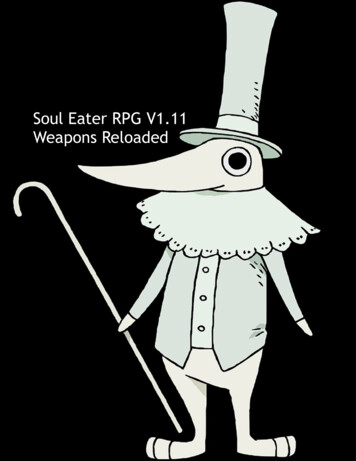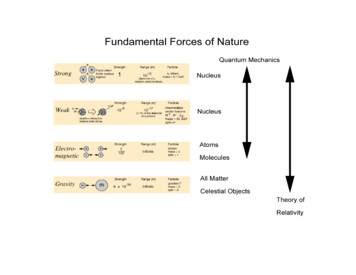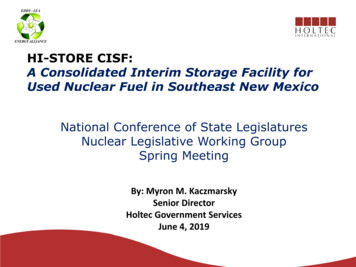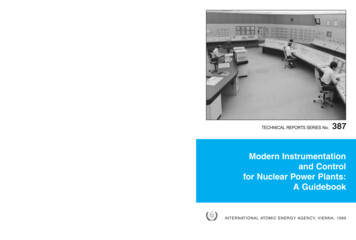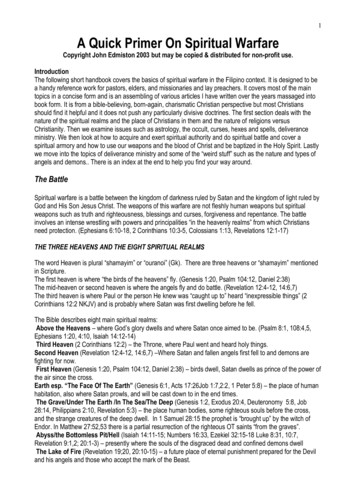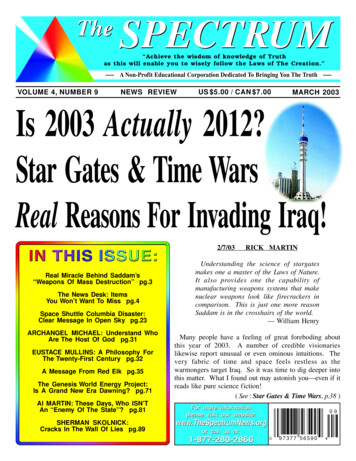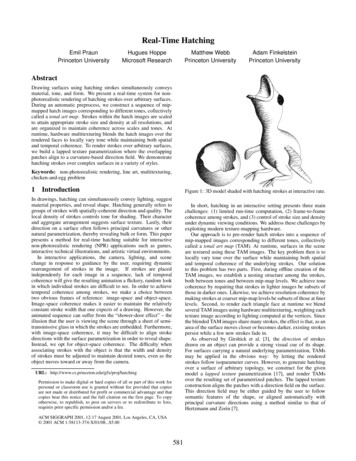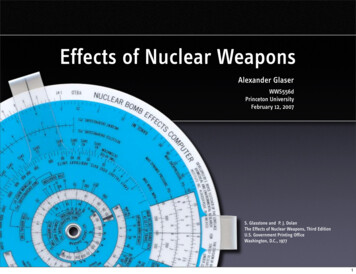
Transcription
Effects of Nuclear WeaponsAlexander GlaserWWS556dPrinceton UniversityFebruary 12, 2007S. Glasstone and P. J. DolanThe Effects of Nuclear Weapons, Third EditionU.S. Government Printing OfficeWashington, D.C., 19771
Nuclear Weapon l10307154521045India (1974, 1998): 1 5Pakistan (1998): ca. 6Total52815172045North Korea (2006): 12
3
Introduction / Overview4
Burst Types Air burstHigh-altitude burst (above 100,000 ft)Underwater burstUnderground burstSurface burstIn the following: primary focus on (medium-altitude) air bursts(fireball above surface, weak coupling into ground)5
Effects of a Nuclear ExplosionTypical distribution of energy released Thermal radiation (including light)(35%)Blast (pressure shock wave)(50%)Nuclear radiation (prompt and delayed)(15%)6
Effects of a Nuclear ExplosionSequence of events, Part IFIREBALLstarts to form in less than a millionth of a second after explosionseveral tens of million of degrees: transformation of all matter into gas/plasmathermal radiation as x-rays, absorbed by the surrounding atmospherefor 1 Mt explosion : 440 ft in one millisecond, 5,700 ft in 10 secondsafter one minute: cooled, no longer visible radiationFormation of the fireball triggers the destructive effects of the nuclear explosion7
Trinity TestJuly 16, 1945Shock frontFireballMach frontDirt cloud8
Effects of a Nuclear ExplosionSequence of events, Part IIRADIOACTIVE CLOUDDuring expansion of the fireball, vaporized matter condenses to a cloudcontaining solid particles of weapon debrisFireball becomes doughnut-shaped, violent internal circulatory motionAir is entrained from the bottom“mushroom” cloud if dirt and debris sucked up from earth’s surface(Source term for radioactive fallout)9
Cutaway showing artist’s conception of toroidal circulation within the radioactive cloudSource: Glasstone, Figure 2.07a10
Effects of a Nuclear ExplosionSequence of events, Part IIIAIR BLAST / SHOCK WAVEPressure wave develops immediately after explosionand moves outward from the fireballAfter 10 seconds of 1 Mt explosion:diameter of fireball: 5,700 ft, distance of shock front: 3 milesWave is reflected from surface, both waves merge to create “Mach wave”THERMAL RADIATIONReemitted radiation from the fireball (secondary thermal radiation)Duration: about 10 seconds for 1 Mt explosion (99% of total thermal energy)11
Heat and Shock Waves(Film footage: Federal Civil Defense Administration, ca. 1955)12
Effects of a Nuclear ExplosionSequence of events, Part IVINITIAL (PROMPT/DIRECT) NUCLEAR RADIATIONDefined as radiation releases within the first minutemostly neutrons and gammas (directly from the explosion or from fission products)DELAYED NUCLEAR RADIATION / FALLOUTOrigin: material lifted into the fireball right after the explosionMixed with radioactive residues of weapon (activated debris, fission products, .)Early and delayed fallout: Depending on height of burst, weather conditions, etc.13
Air Blast14
Shock Wave and Winds VelocitiesPeak overpressure100 psi50 psi20 psi10 psiMax. wind velocity1400 mi/hr900 mi/hr500 mi/hr300 mi/hrSource: Glasstone, Figures 3.21 and 3.04, Table 3.0715
Damage Characteristics forSpecific OverpressuresRepresentative data, e.g. from Physical Vulnerability HandbookDamageLight housing destroyedOverpressure5 psiBrick housing/commercial buildings destroyed10 psiReinforced concrete structures destroyed20 psiNuclear weapon storage bunkersCommand bunkersMissile silosDeep underground command facilities100-500 psi100-1000 psi500-10000 psi1000-10000 psi16
Percentages of Population Killed(as a function of peak overpressure)98%Source: NRDC, The U.S. Nuclear War Plan: A Time for Change, 2001Original source: OTA, The Effects of Nuclear War, 197917
dh3 Yh1d1Peak overpressures on the ground for a 1-kiloton burst (intermediate-pressure range)Source: Glasstone, Figure 3.73b18
Analysis of Attackson Hiroshima and Nagasakih 3Y h1Calculated value of the Height of Burst (HOB) for 15 psiHiroshimaNagasakih 3h 3Real value15 670 ft 1650 ft1640 ft22 670 ft 1880 ft1900 ftHeight of Burst at Hiroshima and Nagasaki chosen to maximize areaover which 15 psi or more occurs (1.1-1.3 miles in diameter)(2.5x times more area destroyed compared to surface burst)19
2 Mt: 5.7 mi200 kt: 2.7 mi20 kt: 1.2 miHeight of burst selected to maximize area over which 15 psi or more occurs20
Impact of Fizzle-Yield Explosion(Area of complete destruction)3 kt2 ktSource: Ted Postol, MIT21
Thermal Radiation22
Thermal Fluence and its Effects" 3.07 Y(kt)f τ!2Q cal/cm R(miles)2Glasstone, Equation 7.96.4Thermal partition f: about 0.35; Transmittance to target on the ground: Figure 7.98Type of materialEffectQ(min)Human skinSecond degree burns6 cal/cm2Human skinThird degree burns10 cal/cm28-9 cal/cm2Fine or course grassDeciduous leavesIgnitesPaperCotton shirt (khaki colored)6 cal/cm24-10 cal/cm221 cal/cm2Glasstone, Tables 7.35 and 7.4023
Mass FiresInitial fires (started by the thermal radiation) combine and form “super fire”Minimum thermal fluence required: about 10 cal/cm2High velocity winds directed towards center of fire, “chimney effect”Firestorm developed in Hiroshima about 20 minutes after explosionDeath caused by heat or suffocation24
Mass fire: 7.0 mi200 kt: 2.7 mi25
Nuclear Radiation26
Effects of Acute Whole BodyExposure to Radiation1-2 Sv2-5 Sv5-10 Sv10-50 Sv 50 SvIncidence0-50%50-90%100%100%100%Latency 3 hrs1-2 hrs0.5-1 hr0.5 hrMinutesLethality0-10%0-90%0-90%90-100%100%Death occurs withinMonthsWeeksWeeks2 weeks1-48 hrsIntestinalNervousInitialSymptomsLeading systemBlood forming (bone marrow)Source: United Nations Scientific Committee on the Effects of Atomic Radiation: Sources, Effects, andRisks of Ionizing Radiation. 1988 Report to the General Assembly, United Nations, New York, 1988.Annex G, Early effects in man of high doses of radiation, in particular, Table 13. Similar informationis listed in Glasstone, Table 12.108.100 rad 1 Gy27
Initial Radiation(Dose absorbed in the first minute after explosion)1000 rads for 20 kt explosionDiameter: 2 x 4100 ft (ca. 1.5 mi)28
FalloutEarly fallout fraction for surface burst: 40-70% within one dayFallout pattern is difficult to predictStrongly depends on terrain and meteorological conditionsFission products and other radioactive debris condense ontosolid and molten soil minerals (Particle size: 0.001-1 mm)29
Methodology to Predict Fallout(cf. Glasstone Figure 9.26, Figure 9.93, and Table 9.93)30
Total-dose contours from early fallout after asurface burst with a total yield of 2 megatons and1-megaton fission yield (15 mph effective windspeed).Source: Glasstone, Figure 9.86b1000 rads (10 Gy):Dose to (unprotected) humans at a distance of30 miles from explosion (in the direction of wind)Total area: about 200 square miles31
Estimated local (integrated) dose contours in rads at 96 hours after the BRAVO (15 Mt) test explosionSource: Glasstone, Figure 9.10532
Source: Ted Postol, lecture notes33
“[I]t seems reasonable to assume that the destruction of,say, 25 percent of its population (55 million people) and morethan two-thirds of its industrial capacity would mean thedestruction of the Soviet Union as a national society. Such a levelof destruction would certainly represent intolerable punishmentto any industrialized nation and thus should serve as an effectivedeterrent.”Secretary of Defense McNamaraNovember 21, 1962 memo to President Kennedy34
35
Conclusion / Epilogue36
“Duck and Cover”Federal Civil Defense Administration, 195137
“The Day After”ABC Television, November 198338
39
Fallout Early fallout fraction for surface burst: 40-70% within one day Fallout pattern is difficult to predict Strongly depends on terrain and meteorological conditions Fission products and other radioactive debris condense onto soli
